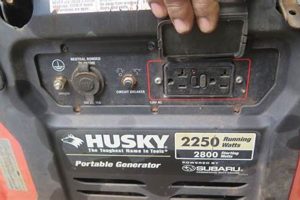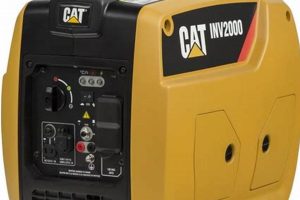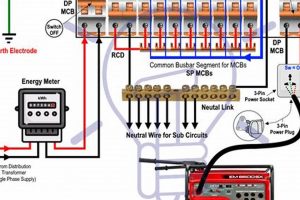Compact, independent power sources offer a practical solution for various needs, from emergency home backup to powering tools at remote job sites or recreational activities. These units typically employ gasoline-powered internal combustion engines to drive an alternator, producing electrical current. Different models offer varying power outputs, fuel efficiency, and features such as multiple outlets, noise reduction technology, and automatic shutdown safeguards.
Access to reliable electricity is essential in modern life. These independent power sources provide crucial support during power outages, ensuring continuity for critical appliances and devices. Their portability expands their utility beyond the home, enabling professionals in construction, landscaping, and event management to operate power tools and equipment wherever needed. Furthermore, they facilitate outdoor recreational activities, providing power for camping, tailgating, and other off-grid pursuits. The development of more efficient and quieter models has broadened their applicability and reduced their environmental impact.
The following sections will explore various aspects of these mobile power solutions in greater detail, including key selection criteria, proper usage guidelines, maintenance recommendations, and a comparison of available models and technologies.
Operating Compact Power Generators Safely and Effectively
Safe and efficient operation of independent power sources requires careful consideration of several factors. Adhering to recommended practices ensures optimal performance, prolongs equipment lifespan, and mitigates potential hazards.
Tip 1: Proper Placement is Crucial: Always operate units outdoors in well-ventilated areas, away from doors, windows, and flammable materials. Carbon monoxide poisoning is a serious risk.
Tip 2: Grounding is Essential: Proper grounding protects against electrical shock. Consult the owner’s manual for specific grounding instructions.
Tip 3: Fuel Handling Safety: Allow the engine to cool completely before refueling. Store fuel in approved containers in a well-ventilated area away from ignition sources.
Tip 4: Regular Maintenance: Routine maintenance, including oil changes, air filter cleaning, and spark plug replacement, ensures optimal performance and extends the unit’s lifespan. Refer to the owner’s manual for the recommended maintenance schedule.
Tip 5: Load Management: Avoid overloading the generator. Calculate the total wattage of devices to be connected and ensure it is within the generator’s rated capacity.
Tip 6: Weather Protection: Protect units from the elements. Exposure to rain, snow, or excessive heat can damage components and compromise performance.
Tip 7: Safe Storage: When not in use, store the generator in a dry, secure location away from children and pets. Drain the fuel tank before long-term storage.
Adherence to these guidelines promotes safe and efficient operation, maximizing the benefits of mobile power solutions while minimizing risks.
By following these essential tips, users can ensure reliable power generation for various needs, from emergency backup power to recreational applications.
1. Power Output
A critical factor in selecting a compact, independent power source is its power output, measured in watts. This specification directly determines the number and type of devices the unit can power simultaneously. Understanding power output is essential for matching the generator to the intended application and avoiding overload, which can damage both the generator and connected equipment.
- Starting vs. Running Watts
Electrical devices often require a surge of power upon startup (starting watts), which is higher than the power needed to maintain operation (running watts). Generators specify both values. For example, a refrigerator might require 1,200 starting watts but only 700 running watts. The generator’s starting wattage must accommodate the highest starting wattage of any device connected, while its running wattage must support the combined running wattage of all devices operating concurrently.
- Wattage Requirements of Common Devices
Different devices have vastly different wattage requirements. A small LED light bulb might consume only a few watts, while a power-hungry appliance like an air conditioner can demand several thousand watts. Accurately assessing the wattage needs of intended devices is essential for selecting a generator with adequate capacity.
- Overload Protection
Many modern compact power sources incorporate overload protection mechanisms, such as circuit breakers, to prevent damage from exceeding the rated output. While these safeguards protect the generator, they also underscore the importance of careful load management. Regularly exceeding the generator’s capacity, even with overload protection, can shorten its lifespan.
- Matching Power Output to Application
Choosing the right power output depends on the intended use. Emergency home backup during a power outage necessitates considering critical appliances like refrigerators, sump pumps, and furnaces. For recreational use, such as camping, the power needs will likely be lower, focusing on lighting, small electronics, and perhaps a small refrigerator or electric grill.
Careful consideration of power output requirements, including starting and running watts, ensures optimal generator performance and prevents damage from overload. Accurately assessing power needs based on intended applications is crucial for selecting the appropriate generator and maximizing its effectiveness. Overload protection features offer a safeguard but should not substitute for prudent power management.
2. Fuel Efficiency
Fuel efficiency represents a critical aspect of compact, independent power source operation, directly influencing operational costs and environmental impact. Expressed as run time per unit of fuel (e.g., hours per gallon), this metric dictates how long a unit can operate on a given fuel tank capacity. Higher fuel efficiency translates to longer run times, reduced fuel expenses, and fewer refueling interruptions. Technological advancements, such as inverter technology and advanced engine designs, contribute to improved fuel efficiency in modern units. For instance, inverter generators adjust engine speed based on power demand, unlike traditional generators that operate at a constant speed, resulting in significant fuel savings, especially at lower loads. This efficiency is crucial in extended operations, such as during power outages or remote work projects.
The practical implications of fuel efficiency extend beyond cost savings. In remote locations or during emergencies, access to fuel may be limited. A fuel-efficient unit extends operational capabilities, reducing logistical challenges associated with fuel resupply. Furthermore, reduced fuel consumption contributes to a smaller environmental footprint by minimizing emissions. Consider a scenario where two generators with equivalent power output operate for eight hours. A less fuel-efficient model consuming one gallon per hour necessitates eight gallons of fuel, while a more efficient model consuming half a gallon per hour requires only four. This difference significantly impacts both operating expenses and environmental impact over extended use.
Selecting a fuel-efficient compact power source requires careful evaluation of specifications and features. Inverter technology often yields higher efficiency, but other factors, such as engine design and load management, also play a role. Matching the generator’s power output to the actual load further optimizes fuel consumption. Avoiding unnecessary overloading and utilizing power-saving practices contribute to efficient operation. Understanding and prioritizing fuel efficiency contributes to cost-effective, environmentally responsible, and logistically sound power generation.
3. Portability
Portability represents a defining characteristic of compact, independent power sources, directly influencing their practical applications and user experience. The ease with which a unit can be transported and positioned significantly impacts its suitability for various uses, from emergency home backup to remote job sites and recreational activities. Evaluating portability involves considering factors such as weight, dimensions, and integrated handling features.
- Weight and Dimensions
The physical size and weight of a unit directly affect its portability. Lighter, more compact models are easier to transport and maneuver, especially in challenging terrain or confined spaces. For applications requiring frequent relocation, such as on construction sites or during outdoor events, weight and dimensions become paramount considerations. Manufacturers often provide detailed specifications, including dry weight (without fuel) and overall dimensions, allowing users to assess suitability for their specific needs. For instance, a lightweight model might be easily carried by a single individual, while a heavier unit might require a wheeled frame or multiple people for transport.
- Integrated Handling Features
Features like built-in handles, wheels, and folding frames enhance portability. Ergonomically designed handles facilitate lifting and carrying, while sturdy wheels simplify transport over uneven surfaces. Folding frames reduce the unit’s footprint for storage and transport. These features contribute to user convenience and reduce strain during relocation. A unit equipped with never-flat wheels and a telescoping handle, for example, significantly simplifies transport across various terrains.
- Impact on Application
Portability requirements vary significantly depending on the intended application. For emergency home backup, a unit might remain stationary in a designated location, minimizing the importance of portability. Conversely, for outdoor recreation or remote work, portability becomes crucial, enabling users to transport the generator easily to campsites, job sites, or other off-grid locations. A compact, lightweight model becomes essential for backpacking or hiking, while a larger, wheeled unit might be more appropriate for powering equipment at a remote construction site.
- Balancing Portability with Other Factors
Portability often involves trade-offs with other factors, such as power output and runtime. Smaller, lighter units typically offer lower power output and shorter run times compared to larger, heavier models. Balancing portability with power needs and desired runtime requires careful consideration of the intended application and priorities. For example, a user might prioritize portability for a camping trip, accepting a lower power output and shorter runtime, while a contractor might prioritize higher power output for operating power tools, accepting a less portable unit.
Portability significantly influences the practicality and usability of compact, independent power sources. Careful consideration of weight, dimensions, and integrated handling features, alongside application-specific needs, ensures optimal selection. Balancing portability with power output, runtime, and other factors requires a thorough assessment of priorities and intended use cases. The right balance maximizes the benefits of mobile power generation across diverse applications.
4. Runtime
Runtime, a crucial operational parameter of compact, independent power sources, defines the duration a unit can operate continuously on a single fuel tank. This characteristic significantly influences usability, dictating the period for which power is available without refueling. Understanding runtime and its influencing factors is essential for effective power planning and ensuring uninterrupted operation for the intended duration.
- Fuel Tank Capacity
The fuel tank capacity directly correlates with potential runtime. Larger tanks generally enable longer operation before refueling. However, larger tanks also contribute to increased weight and size, impacting portability. A larger fuel tank, while providing extended runtime, might be less suitable for applications requiring frequent relocation. Conversely, a smaller, lighter unit with a smaller fuel tank might be preferable for portability despite requiring more frequent refueling.
- Engine Efficiency and Load
Engine efficiency and the applied load significantly influence runtime. More efficient engines consume less fuel per unit of power output, extending runtime for a given fuel tank capacity. Similarly, operating the generator at lower loads consumes less fuel and extends runtime. Operating a generator well below its maximum rated output often extends runtime considerably, conserving fuel and reducing operational costs.
- Fuel Type
Different fuel types offer varying energy densities, impacting runtime. Gasoline, propane, and diesel are common fuels for compact power sources, each with its own characteristics. Propane, for example, often burns cleaner than gasoline but might offer slightly lower energy density, potentially impacting runtime. The choice of fuel also influences storage and availability considerations, particularly in remote locations or during emergencies.
- Environmental Factors
Environmental factors, such as temperature and altitude, can influence engine performance and, consequently, runtime. Extreme temperatures or high altitudes can affect combustion efficiency, potentially reducing runtime. Operating instructions often provide guidance on adjusting for these environmental factors to optimize performance and maximize runtime in challenging conditions.
Understanding runtime and its interplay with fuel tank capacity, engine efficiency, load, fuel type, and environmental conditions is fundamental for effective power planning. Matching the anticipated runtime needs with the generator’s capabilities ensures uninterrupted operation for the desired duration. Careful consideration of these factors optimizes fuel consumption, reduces operational costs, and maximizes the utility of compact, independent power sources for diverse applications.
5. Noise Levels
Noise levels represent a critical consideration when selecting and operating compact, independent power sources. Excessive noise can disrupt residential areas, impact work environments, and detract from recreational activities. Understanding the factors influencing noise production and available noise reduction technologies is crucial for minimizing disturbance and ensuring harmonious operation within various settings.
- Decibel Levels and Human Perception
Noise levels are typically measured in decibels (dB). A logarithmic scale, even small increases in dB values represent significant increases in perceived loudness. A difference of 10 dB is perceived as roughly twice as loud. Prolonged exposure to high dB levels can cause hearing damage. Understanding dB levels associated with different generator models allows users to select units appropriate for their environment and adhere to noise regulations. A generator operating at 70 dB, for example, is significantly quieter than one operating at 90 dB. For comparison, normal conversation is around 60 dB, while a busy city street might reach 80-90 dB.
- Factors Influencing Noise Production
Several factors contribute to noise generation in compact, independent power sources. Engine design, exhaust systems, and overall construction play significant roles. Traditional generators with larger engines typically produce more noise than smaller inverter generators. Furthermore, operating a generator at higher loads generally increases noise output. Understanding these factors allows users to make informed choices and adopt operational practices to minimize noise pollution. Selecting a model with noise-reducing features like mufflers and sound-dampening enclosures significantly contributes to quieter operation.
- Noise Reduction Technologies
Manufacturers employ various technologies to mitigate noise output. Mufflers and exhaust systems designed to dampen sound are common features. Some models incorporate sound-dampening enclosures or advanced engine designs that minimize noise production at the source. Inverter generators, by adjusting engine speed based on demand, often operate at lower speeds and produce less noise than traditional generators, especially at lighter loads. Choosing a generator incorporating these technologies contributes to a quieter operational experience.
- Regulations and Considerations
Many communities have noise ordinances restricting permissible noise levels, particularly during certain hours. Operating a generator that exceeds these limits can result in fines or other penalties. Users must be aware of and comply with local regulations. Beyond legal requirements, consideration for neighbors and the surrounding environment promotes responsible generator usage. Operating generators during reasonable hours and minimizing noise output contributes to a positive community experience.
Noise levels are an important consideration in selecting and operating compact, independent power sources. Understanding dB levels, influencing factors, noise reduction technologies, and local regulations enables informed decision-making and responsible operation. Prioritizing quieter operation minimizes disturbance, promotes harmonious coexistence, and enhances the overall user experience, ensuring that mobile power generation contributes positively to various environments, from residential settings to remote work locations and recreational activities.
Frequently Asked Questions about Compact Power Generators
This section addresses common inquiries regarding the selection, operation, and maintenance of compact, independent power sources.
Question 1: How is the appropriate generator size determined?
Generator size selection depends on the intended power requirements. Calculate the combined running wattage of all devices planned for simultaneous operation, adding a margin for starting wattage surges. Consulting wattage requirements listed on appliances and electronic devices aids accurate assessment. Overestimating power needs slightly is generally advisable to accommodate unexpected demands.
Question 2: What safety precautions are essential during operation?
Operating a generator outdoors in a well-ventilated area, away from structures, is crucial to prevent carbon monoxide poisoning. Proper grounding protects against electrical shock. Allowing the engine to cool before refueling and storing fuel safely are essential fire prevention measures. Consulting the owner’s manual for model-specific safety guidelines is paramount.
Question 3: How does inverter technology benefit generator performance?
Inverter technology regulates voltage and frequency more precisely than traditional generators, offering cleaner power output suitable for sensitive electronics. Inverter generators also adjust engine speed based on demand, resulting in improved fuel efficiency and quieter operation, especially at lower loads.
Question 4: What maintenance is recommended for optimal generator lifespan?
Regular maintenance is essential for reliable performance and longevity. This includes routine oil changes, air filter cleaning or replacement, and spark plug replacement. Consulting the owner’s manual for the manufacturer’s recommended maintenance schedule specific to the model ensures proper care.
Question 5: What considerations apply to generator fuel storage and usage?
Storing fuel in approved containers in a well-ventilated area, away from ignition sources, is crucial for fire safety. Using fresh, stabilized fuel prevents engine issues and optimizes performance. Draining the fuel tank before long-term storage prevents carburetor clogging and other fuel-related problems.
Question 6: What distinguishes different fuel types used in portable generators?
Common fuel types include gasoline, propane, and diesel. Gasoline is widely available but requires proper storage to prevent degradation. Propane offers cleaner burning and longer storage life but may have slightly lower energy density. Diesel provides high efficiency and longevity but can be more expensive and produce more noise and emissions. Fuel type selection depends on operational priorities, environmental considerations, and fuel availability.
Addressing these frequently asked questions aims to provide a comprehensive understanding of compact power generator selection, safe operation, and proper maintenance, empowering users to make informed decisions and maximize the benefits of these versatile power solutions.
The subsequent section offers an in-depth comparison of various generator models and technologies, facilitating informed selection based on individual power requirements and application scenarios.
Compact Power Generators
This exploration of compact, independent power sources has highlighted their crucial role in ensuring power availability across diverse scenarios. From emergency preparedness to professional applications and recreational pursuits, these versatile units offer essential support. Key considerations, including power output, fuel efficiency, portability, runtime, and noise levels, guide informed selection based on specific power requirements and usage contexts. Safe and efficient operation hinges on adherence to proper placement, grounding, fuel handling, and maintenance procedures. Understanding the nuances of different fuel types and noise reduction technologies further optimizes performance and minimizes environmental impact. Addressing frequently asked questions empowers users with the knowledge to navigate the selection process effectively and harness the full potential of these mobile power solutions.
As technology continues to advance, further refinements in efficiency, noise reduction, and fuel versatility are anticipated. Compact power generators represent an evolving landscape of innovation, poised to play an increasingly vital role in ensuring power resilience and enabling mobile power access in an ever-changing world. Careful consideration of individual needs and a commitment to responsible usage practices will maximize the benefits of these invaluable tools, empowering users with reliable power access wherever and whenever it is required.






